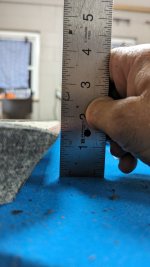Hard Knock Cues
Well-known member
These are old photos from a table I picked up about 6 years ago. One of those I've got some in-laws that want to get rid of this old beat up table that's taking up too much room, so I grabbed it. I put it together with new cloth and rubber back then. Knowing the things I've learned from all of you on AZ billiards, I'm going to redo it again. Along with rail adjustments because of it's age and the need to make it play better.
I believe it's a 1912 St. Elmo's by Brunswick. It is a bit of a Frankenstein because there is no head rail. There are two number four rails and I think two number five rails. The legs look like they were rebuilt out of 2x8, So they don't have the inlay work the sides have. The aprons are not original. According to the story, when the people originally built the house in to 70's, an Italian man built the table for the people. The in-laws bought the house around 2000 or so and the table came with the house. I imagine there were a couple tables in a basement somewhere that got ruined by flood or something and somebody put together a table out of a couple.
Anyway, some interesting things are how the pockets are cut into the slate which is an inch and a half thick. Makes me wonder if it was a homemade job from say a set a slate from a carom table. There were some obviously old remnants of lead in the joints where the wood meets the slate and also in the joints between the pieces. Then plaster Paris possibly and wax was used at a later time. I reworked all the pockets and used Bondo so when I uncover it I'll send those pictures out. When I did it I used the black j&j rubber. so I'm going to reuse them in order to have a real comparison in the effects of making the correct adjustments to the rail bevel.
I'll try to post my progress as I move along but I am having difficulty getting pictures loaded up because I'm a little bit older and not that computer savvy but I'll figure it out like I always try to. I had to screenshot these so I hope they're working for everyone. This is also a part-time thing for me so I'm not always very quick about responding but I'll try.
So my questions are does anybody have any experience with or identifying this table?
Has anyone seen the pockets cut out of the slate this way?
And has anyone seen fragments a lead used in the slate joints?
I'm sure other questions will pop up, but let's start here. Thanks to everyone who has any information that can help educate me.






I believe it's a 1912 St. Elmo's by Brunswick. It is a bit of a Frankenstein because there is no head rail. There are two number four rails and I think two number five rails. The legs look like they were rebuilt out of 2x8, So they don't have the inlay work the sides have. The aprons are not original. According to the story, when the people originally built the house in to 70's, an Italian man built the table for the people. The in-laws bought the house around 2000 or so and the table came with the house. I imagine there were a couple tables in a basement somewhere that got ruined by flood or something and somebody put together a table out of a couple.
Anyway, some interesting things are how the pockets are cut into the slate which is an inch and a half thick. Makes me wonder if it was a homemade job from say a set a slate from a carom table. There were some obviously old remnants of lead in the joints where the wood meets the slate and also in the joints between the pieces. Then plaster Paris possibly and wax was used at a later time. I reworked all the pockets and used Bondo so when I uncover it I'll send those pictures out. When I did it I used the black j&j rubber. so I'm going to reuse them in order to have a real comparison in the effects of making the correct adjustments to the rail bevel.
I'll try to post my progress as I move along but I am having difficulty getting pictures loaded up because I'm a little bit older and not that computer savvy but I'll figure it out like I always try to. I had to screenshot these so I hope they're working for everyone. This is also a part-time thing for me so I'm not always very quick about responding but I'll try.
So my questions are does anybody have any experience with or identifying this table?
Has anyone seen the pockets cut out of the slate this way?
And has anyone seen fragments a lead used in the slate joints?
I'm sure other questions will pop up, but let's start here. Thanks to everyone who has any information that can help educate me.
